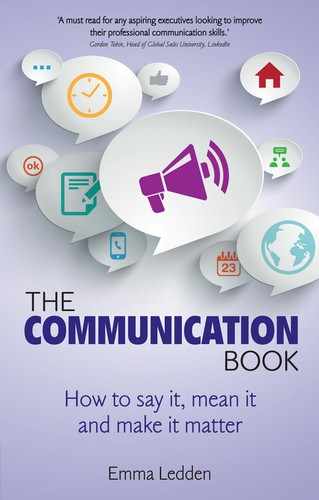What are the first words that come into your mind when you think of Richard Branson?
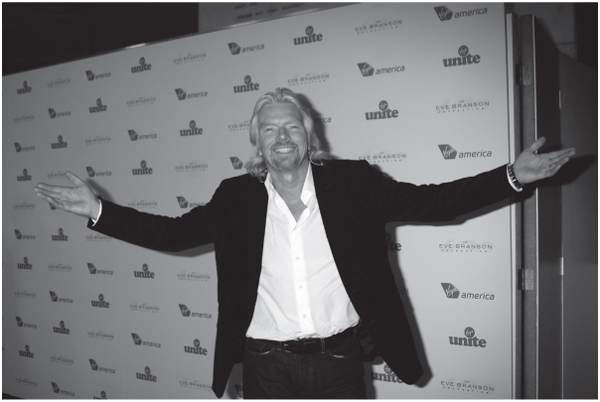
How about the first words that come into your mind when you think of Oprah Winfrey?
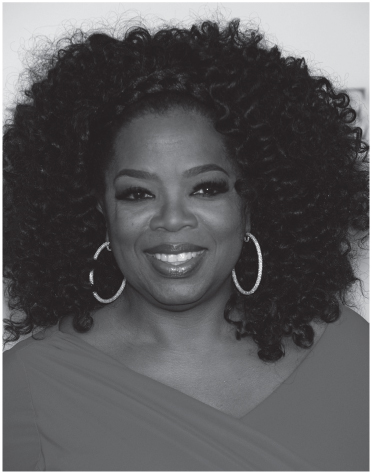
And finally what are the first words that come into your mind when you think of Lady Gaga?
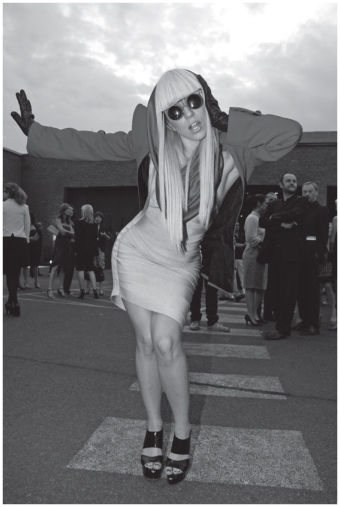
Now, what if I put your picture here?
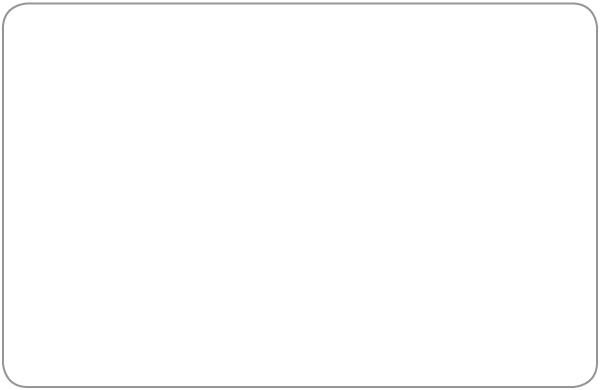
- What words would you use to describe yourself?
- What words would your team use to describe you?
- What words would your manager/superior use to describe you?
Would the words be the same for all three? Would they be the right words? Would they be the words you want used to describe you?
That is a lot of questions. Let me start at the beginning.
It’s a brand new world
The term ‘personal brand’ is believed to have first appeared in the August 1997 issue of Fast Company Magazine, in an article by Tom Peters.
Tom said that we live in the age of the individual. Our working life no longer involves going into one company at 18 years old and working until retirement, safe in the knowledge that time served, rather than suitability, will ensure career progression.
Today, in a world of enormous ambition and fortuitous competition, there is little job security. Careers are created and changed yearly, and the reinvention and expansion of self is vital for success. This is why your personal brand is worth your attention.
Each one of us needs to think of ourselves, brand ourselves and market ourselves as if we are a business such as Nike, Coke or Tommy Hilfiger. We need to be clear on what we are good at, what makes us different and we need to be excited, no, really excited, about our brand before anyone else can be.
To succeed in business today you must be CEO of Me Inc. You have to decide what your personal brand is and then you need to show it to the world in everything you do – confidently and consistently.
This chapter will help you do that.
‘It’s this simple: You are a brand. You are in charge of your brand. There is no single path to success. And there is no one right way to create the brand called You. Except this: Start today. Or else.’
TOM PETERS
Become CEO of Me Inc
I am not here to tell you what your personal brand is or should be.
You choose your own personal brand.
You know if you are Lady Gaga, Richard Branson, Hugh Hefner or Miley Cyrus.
The most important message I want you to get from this chapter is that you are always creating an impression, every day, in every interaction. I want you to be aware of that impression and I want you to be sure you are coming across the way you want and need for your career success.
You are a walking, talking personal brand, whether you like it or not. Today, right now, the way you dress, the way you talk, the way you interact – that is your personal brand. If you refuse to believe in personal brands, that belief is part of your personal brand. Everything you do and everything you choose not to do communicates your personal brand.
Some people I meet feel the idea of a personal brand is too contrived or engineered, but this is not about spin. Being aware of and having a genuine personal brand is not fake; it is simply knowing who you are, identifying your strengths and making sure that when you are out there in the world of work you are representing yourself correctly and honestly every day.
You can develop yourself and your skills as part of your personal brand. You may believe you are quite shy but would like to be known as a great speaker. In this case, you may choose to work on your presentation skills.
However, aside from building new skills, do not try to be something you are not. You will only be able to pretend to be somebody else for so long before you show the world truly who you are.
Who are you?
We live in an age where few people have or want a job for life. We live in this incredibly exciting time where we can be and do anything we want.
If only it was that easy though. Yes, maybe we can be and do anything we want, but to achieve that we must know ourselves, represent ourselves and, in a lot of cases, stand out from others.
There is much written about personal branding, but I believe it is very simply the act of knowing yourself and being who you are, consistently and professionally.
There are three simple steps to identifying and communicating your personal brand:
- Awareness: do a personal brand audit.
- A-list: pick your words.
- Action: put your words into action with the ‘7 Personal Branding Basics’.
Awareness
The first step to identifying your true personal brand is to do a personal brand audit. This exercise will help you identify and become aware of what your personal brand is today.
There are three parts to this exercise.
What three words would you use to describe yourself?
1.
2.
3.
What three words would a work peer use to describe you?
1.
2.
3.
What three words would your manager/superior use to describe you?
1.
2.
3.
You will need to ask your work colleagues and your manager to fill this out. You are looking at your personal brand in work, rather than in your personal life. Some people are different in work than they are in their private life. That is OK. I am sure Lady Gaga doesn’t go around wearing those crazy outfits on a day off.
A-list
This is the fun part: now you get to pick your ideal words, the words you want people to use to describe you. The goal is to get absolute clarity on who you are and what is unique and amazing about you. Remember to be authentic and keep in mind the feedback you got in your audit. Start by circling any words at all that appeal to you and then edit them until you have six words in total.
Accepting
Accomplished
Achievement
Adorable
Adventurous
Affectionate
Ambition
Ambitious
Angelic
Appreciative
Appropriate
Articulate
Artistic
Attentive
Attract
Attractive
Authentic
Authoritative
Awake
Aware
Big picture
Bohemian
Bookish
Brave
Calm
Canny
Capable
Captivate
Careful
Caring
Catalyst
Cheap
Chic
Child-like
Clever
Comfort
Compassionate
Connected
Conservative
Controlling
Cool
Cosmopolitan
Courage
Crazy
Creative
Credible
Cuddly
Cute
Dad
Dapper
Daring
Dark
Dedicated
Dependable
Detail-orientated
Determined
Devoted
Diamond in the rough
Diligent
Direct
Discerning
Distinguished
Diva
Down to earth
Dramatic
Earthy
Eclectic
Educated
Effective
Efficient
Elegant
Emotional
Empathetic
Encourage
Energise
Enlightened
Entertaining
Experienced
Fun
Funky
Glamour
Grace
Humorous
Inspirational
Integrity
Intelligent
International
Joyful
Kind
Mum
Non-judgemental
Non-traditional
Open-minded
Optimistic
Original
Party animal
Perceptive
Perky
Perseverance
Persuasive
Playful
Prepared
Real
Rebellious
Relaxed
Reserved
Responsible
Risk-avoiding
Rule-breaker
Rule-follower
Sensible
Sensitive
Serene
Sexy
Silly
Simplicity
Sincere
Smart
Sporty
Strong
Stylish
Subtle
Sultry
Sunny
Traditional
Transformative
Trendy
Trustworthy
Action
At this stage you have examined and received feedback on your current personal brand and you have chosen the six words you want to be known for, based on the list I gave you.
Now you must figure out how you are going to communicate your brand (those six words) every day in the ways that matter.
Below are the ‘7 personal branding basics’ you need to think about.
1. YOUR VOICEMAIL MESSAGE
Do you use the phone company voice message? Do you record a simple ‘I am not available to take your call now’ message? Do you update it every day and say what you are doing or how available you are? Do you leave a funny message to music? What best represents your personal brand?
2. YOUR EMAIL SIGNATURE
‘Kind regards’, ‘Yours sincerely’, ‘Cheers’, ‘Thanks’, ‘Merci’, ‘Grazie’, ‘Faleminderit’ (that’s thank you in Albanian you know… gotta love Google) are all options for your email signature.
Do you put all your social media contacts and website details at the end of your email? And what about a photo? What best represents your personal brand?
3. YOUR LINKEDIN PROFILE
Are you on LinkedIn? Maybe you are half on it, thinking about going on it or just not sure what to do with it. If you are going to be on it, make sure it represents you properly.
If you need help with this there are great YouTube videos and blogs, and the site itself can help you maximise your profile.
4. YOUR CONTENT
Your emails, proposals and presentations are all a representation of you. You need to make sure they are prepared, spell-checked and on time at the very least.
5. YOUR BUSINESS CARD
Do you need one? If so, it needs to be of good quality. Use both sides and have the right contact details on it. Feel proud handing out your business card and make sure it represents you and your brand.
6. YOUR CLOTHES
I talked about dress in an earlier chapter, along with the importance of being groomed. But dressing for your personal brand is more than that. Dressing for your personal brand is about making a statement with your clothes. It is about saying you are a leader or you are creative or you are non-traditional. It could be the tie or tights you wear. It could be the shoes or the suit. It could be the lipstick or lapels you choose.
A CareerBuilder.com survey reports that 41 per cent of employers state that people who dress better or more professionally tend to be promoted more often than others in their organisation.
Financial services is one of the industries that places the most emphasis on professional dress, as 55 per cent state that people who dress more professionally tend to be promoted more often than others in the organisation. On the other hand, IT and manufacturing are two of the industries that place the least amount of emphasis on professional dress, as only 37 per cent and 34 per cent, respectively, said that employees who dress more professionally tend to be promoted more often than others.
‘Even though we are seeing a trend of more relaxed dress codes in the office, especially in summer, it doesn’t mean that professionalism should go out the window’, said Rosemary Haefner, vice president of human resources for CareerBuilder.com. ‘How you dress can play an important role in how others perceive you at work, and dressing professionally can help you project a motivated and dedicated image.’
Haefner recommends the following tips for dressing professionally on the job:
- Stock your wardrobe: start with the versatile basics, such as a pair of black trousers, a dark trouser suit, some button-down collared shirts and a classic pair of dark shoes. Once you have the staples, you can continue to build your wardrobe to give you plenty of professional options.
- Keep it neat and clean: make sure your trousers, shirts and other clothes are ironed, stain-free and in good condition. When your clothes look sloppy, so do you.
- Steer clear of bar attire: don’t mistake the office for your local watering hole. Leave the slinky shirts, tight trousers and cut-off t-shirts at home.
- Look the part: if you have a client presentation or a meeting with the CEO then dress for the part, making sure you choose appropriate articles of clothing for your role.
The way you dress matters and says so much about you. Make sure you are saying the right thing.
7. YOUR ATTITUDE
Your attitude is visible to everyone.
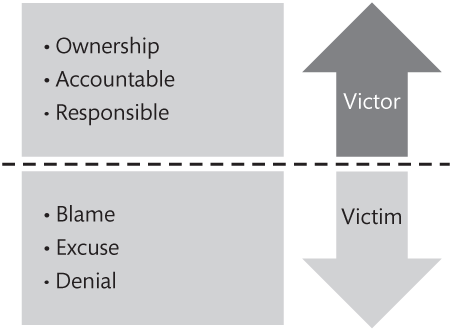
Do you smile or sigh in your everyday interactions? Are you open or insular? Are you stressed or stable? Do you yell and scream at your laptop when it won’t work (me too sometimes) or do you calmly joke of the joys of technology and how precious it is?
You need to ensure your attitude is above the line, as indicated in the diagram on the previous page, so that you are a victor not a victim. You need to approach each day and each exchange with an attitude of ownership, accountability and responsibility.
Everyday etiquette
There is one final area we need to look at under the heading of personal branding and it is what I call ‘everyday etiquette’.
It is up to you to decide to consciously work on your personal brand, but what you do need to be sure you are aware of, every day, is how you are treating other people.
Respect is a behaviour you must display in every interaction. Respect is visible in the things you do. Respect is turning off your phone to listen to someone, not interrupting when someone is speaking and not making the conversation about you all the time.
‘I must respect the opinions of others even if I disagree with them.’
HERBERT H. LEHMAN
As human beings we all have the right to be treated with respect. We have the right to express our feelings and opinions. We have the right to be listened to and taken seriously. We have the right to make a mistake and change our mind. We have the right to ask for what we need, as long as we accept that asking does not necessarily mean we will get it.
In our everyday interactions and explorations respect is displayed in the little things we do.
RULES OF EVERYDAY ETIQUETTE
- Pleases and thank yous: the oldies but still the goodies of modern manners.
- Be on time: being on time shows your respect for the other person. Don’t be late, if you can help it. It’s really rude and everyone else’s time is just as valuable as yours.
- Help others if you see someone whose arms are overloaded with packages, open the door. If you have just entered a building and someone is right behind you, hold the door to keep it from slamming in his or her face.
- Go quietly amid the noise and haste: this world has become very noisy. Be careful not to add to it unnecessarily. Keep your mobile phone ringervolume as low as possible. If you work in an office cubicle, be considerate of your fellow office mates by keeping your voice low while chatting on the phone.
- Parking: this one drives me crazy. Please don’t park across two car park spaces just because they are both free.
